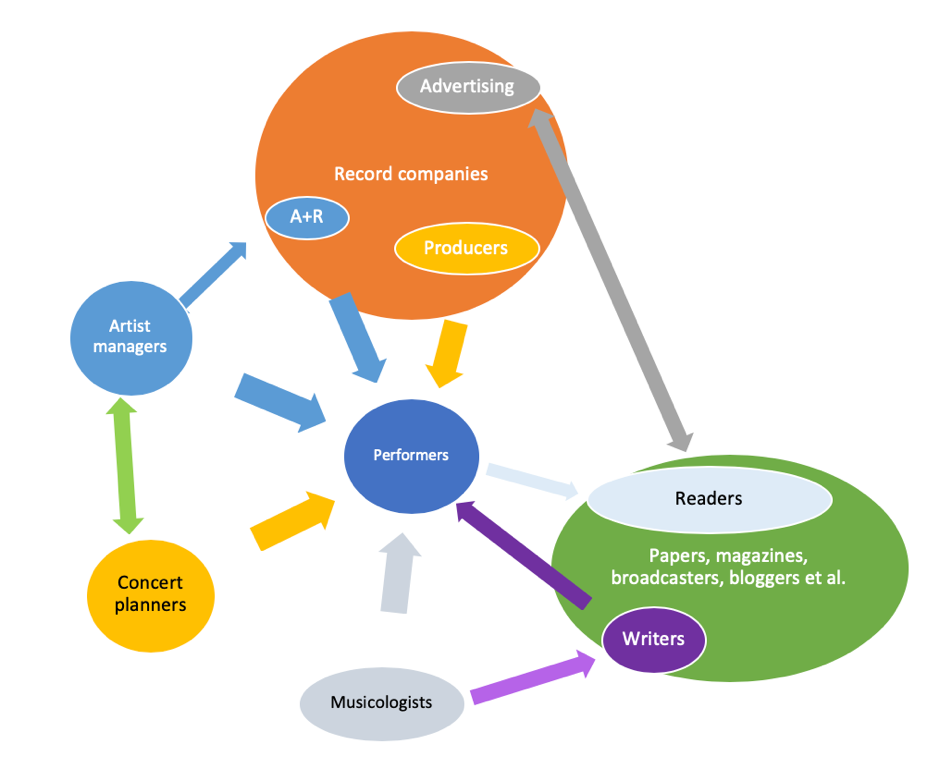7 Teaching
7.1 Introduction: the place of teachers in the WCM State
Music teachers, including (perhaps especially) those who teach children, are central to the dissemination and maintenance of WCM ideology. To understand just how far their reach extends through the music business it may be helpful to create a simplified model of the larger system within which musicians and gatekeepers work.

You’ll see it’s circular – that’s essential to its power, for at every point it’s self-reinforcing. At the outside and at the top I’ve put the record companies, not because they are always leaders (far from it) but because they concentrate the most economic power to disseminate, and thereby to validate, norms. The artists whom the big three companies (Sony, Universal, and Warner) promote necessarily have, or have had until very recently, the greatest reach among all kinds of audiences, in concert and on record. (I use ‘record’ here to include all forms of dissemination of recorded music, although the CD is still surprisingly common in classical.)[1] Recently, YouTube (and streaming more generally) has enabled a handful of stars to form without their help, albeit disseminating the same norms: for the purposes of this model we can include them within this circle, even though they are not reaching the public through quite so many gates.
Through their Artists & Repertoire departments, record companies interact with artist managers (or agents) in deciding whom to promote. Being taken on by a major artist management company is confirmation that your playing or singing has the power to promote norms more persuasively than most. Artist managers interact with concert planners (opera houses, orchestras, venues etc) to get their artists work: both are looking for artists who will attract the largest audiences, providing the kinds of performances they expect and want repeatedly to hear. Record companies also interact through their advertising departments with the musical press, placing advertisements and supplying recordings for review, not infrequently on the understanding that an advertisement will be rewarded by printed coverage (more in this in Chapter 9.3).
As well as a variety of writers and broadcasters, in print and online, this circle includes readers in the sense that they, too, are gatekeeping by buying publications, subscriptions, concert tickets, and recordings, and also because a great many of them, bearing in mind the closed system that keeps WCM culture apart, share the same musical upbringing. This is why at the centre of our model sit the instrumental and vocal teachers. Almost everyone who works in the music business who’s involved in selecting or critiquing artists had music lessons as children, often continuing to young adulthood, and through that process they all absorbed, at an age before they could think critically, a common set of fantasies, and beliefs in those fantasies, about works, the composer-god, the sanctity of the text, about correct style and the correct relationship between composers and performers, and about the correct behaviour that will enable them to succeed as performers, to pass exams, ultimately to get work. (Many of these are examined in chapters 5–6). Musicologists have input here because writers on music have usually done music degrees. And of course musicologists, like everyone else, have learned their underlying musical values from instrumental and vocal teachers. So you have a self-reinforcing system in which everyone shares and promotes the same values.[2]
At the same time, and especially at conservatoire level where the rules of the business are really set in stone, teachers are also performers. Thus in the alternate state of the model (below), the teachers simply switch roles with themselves to become the performers. In so doing they exchange policing for being policed, as those to whom they and their predecessors have taught WCM values and beliefs enforce those normative beliefs back upon performers. Hence the direction of the arrows of influence and enforcement switch as the roles switch: the rest remains unchanged, as it is intended to.

And so by alternating these two states, and looking at the direction of the arrows, we can see how teachers and performers police, and are policed by, the shared ideology which is thus constantly repeated and reinforced.[3] Now we can see just how powerful (how much more powerful than most ever feel) are the teachers of young musicians. What they believe, what they have been led to believe, provides a firm basis on which the ideology can be rebuilt in each new generation.
Continue to 7.2 ‘Childhood lessons’
Back to chapter 7 menu
Back to Contents menu
NOTES
[2] This circular system is comparable to, interacts with and belongs within the self-reinforcing system discussed in Bull, Anna. 2018. Class, Gender, and the “Imagined Futures” of Young Classical Musicians. In Dromey & Haferkorn (2018), 79–95.
[3] Another angle on this model is offered in Chapter 7 and especially 7.7a below.
Leave a Reply
You must be logged in to post a comment.